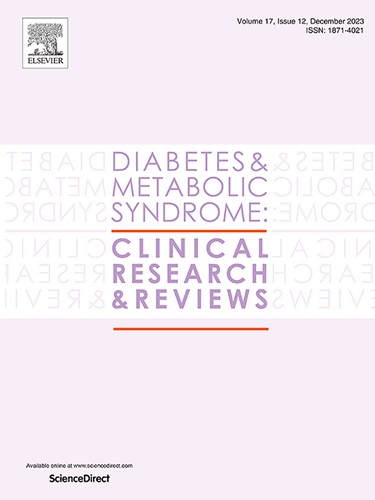Current approach to early gestational diabetes mellitus: A clinical update
IF 3.4
Q1 ENDOCRINOLOGY & METABOLISM
Diabetes & Metabolic Syndrome-Clinical Research & Reviews
Pub Date : 2025-06-01
DOI:10.1016/j.dsx.2025.103256
引用次数: 0
Abstract
Aims
Early gestational diabetes (eGDM) is defined as hyperglycemia diagnosed in early pregnancy (<20 weeks) which is not overt or pre-existing diabetes. This review summarizes our current understanding of eGDM and identifies future research gaps.
Methods
A literature search was conducted using PubMed, Google Scholar and Scopus databases, focusing on the diagnostic pathways, glycemic trajectories, impact of treatment on pregnancy outcomes, and evolving precision medicine approaches in eGDM.
Results
Currently, there is no consensus on the diagnostic criteria and screening approach for eGDM. The WHO 2013 criteria, which adopt IADPSG thresholds for diagnosis throughout the pregnancy are most commonly employed. The pathophysiology involves interplay of defective β-cell function and insulin resistance, however, early-onset gestational insulin resistance is a distinct feature. Nearly 30–50 % of women with eGDM regress to normoglycemia at 24–28 weeks of gestation. Observational studies report that eGDM is associated with increased risk of adverse pregnancy outcomes despite treatment. A recent multicenter randomized controlled trial (TOBOGM) found that immediate treatment of eGDM, compared to deferred or no treatment, is associated with modest neonatal benefits, chiefly driven by the reduction in risk of neonatal respiratory distress. Precision medicine approaches are on horizon in the management of eGDM. Differential enactment pathways have been proposed, wherein women with OGTT results in lower glycemic band are kept under close follow-up, whereas those in the higher glycemic band are treated more aggressively.
Conclusion
eGDM is a distinct medical condition, associated with increased risk of adverse pregnancy outcomes, and modest neonatal benefits upon immediate treatment.
当前治疗妊娠早期糖尿病的方法:临床最新进展
目的:早期妊娠糖尿病(eGDM)定义为在妊娠早期(20周)诊断出的高血糖,而不是明显的或先前存在的糖尿病。这篇综述总结了我们目前对eGDM的理解,并指出了未来的研究差距。方法使用PubMed、谷歌Scholar和Scopus数据库进行文献检索,重点关注eGDM的诊断途径、血糖变化轨迹、治疗对妊娠结局的影响以及不断发展的精准医学方法。结果目前对eGDM的诊断标准和筛查方法尚无共识。最常用的是世卫组织2013年标准,该标准在整个妊娠期间采用IADPSG阈值进行诊断。其病理生理机制涉及β细胞功能缺陷与胰岛素抵抗的相互作用,但早发性妊娠期胰岛素抵抗是一个明显的特征。近30 - 50%的eGDM患者在妊娠24-28周恢复到正常血糖水平。观察性研究报告称,尽管接受了治疗,eGDM仍与不良妊娠结局的风险增加有关。最近的一项多中心随机对照试验(TOBOGM)发现,与延迟治疗或不治疗相比,立即治疗eGDM与新生儿适度获益相关,主要是由于新生儿呼吸窘迫风险的降低。在eGDM的管理中,精准医学方法正在崭露头角。已经提出了不同的制定途径,其中OGTT结果为低血糖带的妇女保持密切随访,而血糖值较高的妇女则更积极地治疗。结论egdm是一种独特的医学疾病,与不良妊娠结局的风险增加有关,立即治疗对新生儿的益处不大。
本文章由计算机程序翻译,如有差异,请以英文原文为准。
求助全文
约1分钟内获得全文
求助全文
来源期刊

Diabetes & Metabolic Syndrome-Clinical Research & Reviews
ENDOCRINOLOGY & METABOLISM-
CiteScore
22.90
自引率
2.00%
发文量
248
审稿时长
51 days
期刊介绍:
Diabetes and Metabolic Syndrome: Clinical Research and Reviews is the official journal of DiabetesIndia. It aims to provide a global platform for healthcare professionals, diabetes educators, and other stakeholders to submit their research on diabetes care.
Types of Publications:
Diabetes and Metabolic Syndrome: Clinical Research and Reviews publishes peer-reviewed original articles, reviews, short communications, case reports, letters to the Editor, and expert comments. Reviews and mini-reviews are particularly welcomed for areas within endocrinology undergoing rapid changes.
 求助内容:
求助内容: 应助结果提醒方式:
应助结果提醒方式:


